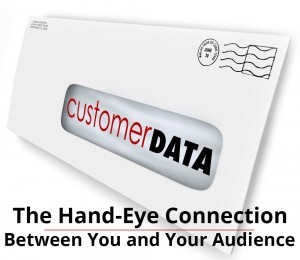Quick Summary
A direct mail marketing campaign is a beneficial way to make potential customers aware of the products or services that your company offers. Find out the practices that will make your campaign successful and the ones that will make it fail. Learn the role that great content copy and graphic design elements play in the success of a campaign. Also, take a look at a case study of a successful direct mail campaign with results.
Quick Links
What is Direct Mail Advertising?
Example of a Successful Direct Mail Campaign
What is Direct Mail Advertising?

Direct mail advertising is your opportunity to take a marketing campaign and place it into the hands of your target market audience. It gives them something physical that they can touch and form an emotional connection with as they learn more about your product or service. It forms a hand-eye connection between your company and your target market audience. When your audience sees an online reference or television advertisement for your business, it will create a mental image of the direct mail piece they received from you.
Direct mail advertising comes in the form of coupons, brochures, packages, postcards and virtually any other type of direct mailer piece you can imagine. You can create direct mail pieces in house or utilize a printing service to create these pieces on your behalf. Direct mail advertising is sent via the U.S. Postal Service, so you will need physical address information for every target market customer on your direct mailing list.
The design is relatively straightforward in that your marketing campaign message, sales offer or announcement is the central focus of each piece. Following this information is a call to action telling your target market audience what steps you want your audience to take next. Finally, your company contact information is on the direct mail piece, so the target customers identify with who you are and what you are offering them.
Does It Work?
Many skeptics believe that modern technology replaces the need for direct mail advertising campaigns. Marketing statistics, on the other hand, show that direct mail advertising is still alive and well.
The United State Post Office states that 78 percent of consumers admit to reading each piece of mail that arrives in their mailbox. In the 18 to 34-year-old age bracket, 40 percent of consumers immediately read their mail and find the information useful as well. This is a clear indication that modern technology has no impact on how much people still love receiving personal mail. As reported in Direct Marketing News, direct mail boasts a strong response rate, with catalogs recording the highest engagement response levels. These response rates become higher when a digital call to action method is part of a mailing piece. Integrating a mobile marketing feature creates an interactive element that makes consumers want to find out more about the offer currently in their hands.
Direct mail is still effective because mailing pieces are available in a variety of formats. Marketers can select postcards, letters, brochures or catalogs as the format to deliver a message or offer an incentive to customers. Each of these options maintains the ability to provide customized content that speaks directly to the consumer. Personalization options often include utilizing a customer’s first name or creating content around their last purchase or inquiry with a business.
Market segmentation is another reason why direct mail campaigns are successful. Marketers can define target audience segmentation groups by purchasing behavior, demographics or geographic location to a company office or store. These segmenting capabilities work to provide direct mail campaigns with higher response rates. This allows marketers to predict how a segmentation group will respond to a direct mail offer. Knowing this information, in addition to the purchasing behavior of a particular target group, allows marketing teams to create direct mail campaigns with measurable results before the mailing pieces are sent out.
These results are a clear indication that direct mail advertising is a viable marketing campaign component that should be a consideration for your business.
Direct Mail Do’s

As with any marketing campaign, you are free to run a direct mail advertising campaign as you see fit. However, there are some things you need to include to make sure your campaign is a success.
- Call to Action
A marketing campaign is only as good as the action you want customers and
prospects to take. You need to be direct in letting them know what actions you want them to execute. Therefore, the very first thing you need to do for you next direct mail campaign is to include a direct call to action.
This is where high-quality direct mail copywriting first comes into play. Your call to action needs to be clear and concise in its words, and stand out from additional content on the marketing piece. It needs to appear a minimum of two times, once on the front of the piece and once on the back of the piece.
- Images
You need to include images and graphics that will stand out from the crowd. The right ones will catch your eye first and allow you to notice any additional content second. The right image can also enhance your calls to action.
A picture is worth a thousand words and, in this case, that picture will tell your story before a customer reads the content on the direct mail piece. Select an image that allows a reader to paint a mental picture of how that image would appear in his life. The right image will pull a reader into your message’s content, prompting him to develop an emotional connection to your offer.
You want the image to be specific to the offer but not so specific that the reader spends more time figuring out what the image is as opposed to focusing on your message.
- Font
Your message needs to reach your target customer as clearly as possible. Avoid an overuse of varied font styles and sizes on your direct mail piece. A good rule of thumb to follow is to keep it simple. Use one larger-sized font for the headline, and another smaller, different style font for the main body content of the piece.
The last thing you want is your message getting lost in the design element of the marketing piece. This can leave your customer wondering what they are looking at as they hold your marketing piece in their hand.
- Make Violations
The key to making a marketing piece successful is to include direct mail creative elements that draw your target customer’s attention away from the main content. By doing this, you will be redirecting their attention towards your sales pitch, call to action or discounted offer you are putting on the table. Think of this approach as being similar to pop-up advertisements when you visit a web page.
- Be Consistent
A direct mail piece is your one shot to go in front of a potential customer and make that all-important first impression. Consistency is the key to making the right impression. You want to give off a professional appearance and imply that you are the only possible solution for satisfying a need or providing a service that a potential customer seeks.
The front side and back side of your marketing piece should complement each other. If you use blue and yellow bursts with content inside on the front, make sure that same setup appears on the back. All fonts should be the same type, utilizing different sizes as you need to make things like the title and contact information stand out.
- Be Colorful
You want your direct mail piece to stand out, but not blind your recipient. Ideally, you need to select three to four colors to use on your marketing piece. Anything more than this and your reader may have to redirect focus back to your content message several times. This causes your message to get lost. Once that happens, your reader is likely to throw your marketing piece away without reading any more information.
- Customize It
To make your marketing piece stand out from the crowd, you need to think outside the box. Select a textured coating as a cover finish, or attach a piece of candy or a special treat to your mail piece.
Create a unique border that stands slightly higher than the rest of the marketing piece. Turn a portion of your marketing piece into a calendar magnet that customers can remove and place on their refrigerator to be reminded of your company and product or service each time they glance at the magnet. There are no right or wrong answers; your customization options only face the limits of your imagination.
- Discounts
Life is busy in most households, so your potential customers don’t want to spend a great deal of time looking for exactly what it is that you are offering. It is imperative that your direct mail piece includes a coupon or discount code that is easy to locate and use when the potential customer is ready.
You can make a coupon that appears on the right-hand side of the marketing piece that can be torn off by a perforated line, making it easy for the customer to place it in his wallet, by his car keys, in a purse, or somewhere else easily accessible. Add a discount code to your call to action feature, making sure to state clearly what the discount offers, what the discount code is, what your website address is, and how long the potential customer has to take advantage of that offer.
- It’s in the Design
Part of any successful marketing campaign is knowing how your target audience prefers to receive new information. It comes down to the details of things such as messaging, color choices, layout and delivery format. You can create the greatest marketing piece of your business career, but if it is not how your target audience prefers to receive things, the message will be lost.
- Postal Rules
A vital aspect of running a successful direct mail advertising campaign is the United States Postal Service. There are rules and regulations in place regarding the design and mailing elements that are acceptable for mailing to your target audience list.
Guidelines set by the postal service determine what sizes and shapes are acceptable for your marketing pieces. Your customer addresses and your business contact address must meet additional requirements regarding how this information appears on each piece. Failure to follow these guidelines will result in your direct mail pieces being rejected from the post office. That would be a costly mistake.
- Simple and Sweet
One of the most important things you want to do with a direct mail campaign is to keep things simple. Avoid using filler words just to take up space when writing copy. Keep your content design clean, and avoid overloading it with more information than what your potential customers needs to make a decision. You can run one campaign now and another one in two weeks. The second campaign can have additional information.
These tips will help kick your direct mail marketing campaign off on the right foot. Each one ensures you are placing the right message in front of your target audience. As with any advice, there are some things that you want to make sure to avoid doing at all costs when running a direct mail marketing campaign.
Direct Mail Don’ts
When preparing a direct mail advertising campaign, you need to put personal preference aside for the time being. You are not creating this campaign to attract your attention. You already think your product or service is fantastic. A direct mail campaign is about attracting the attention of your target market audience. To ensure this happens, avoid making some of these mistakes.
- Not Focusing on Your Mailing List
The most important ingredient to your direct mail campaign is your mailing list. It contains the contact information of the potential customers that you are wanting to specifically target with an offer or promotional incentive. If you target the wrong audience, it’s almost impossible to have a successful campaign.
Work with a professional list broker to help you fine-tune your mailing list. You want to have a clear picture of your target audience so you can choose the best demographic and behavioral selects. The end result is a mailing list of your ideal target audience for the offer you’re sending out.
The bottom line is that you can have a very strong promotional incentive, yet sending it out to the wrong target market audience will result in an unsuccessful direct mail campaign. Keep this from happening by focusing as much attention as possible on developing your mailing list.
- Sending Without a Test
Sending a direct mail campaign without testing it out first is setting yourself up for failure. Testing a campaign before you put it into full force allows you to see firsthand what works, what isn’t working and what you can improve on before the campaign rolls out to a larger audience. When you don’t take the time to test a campaign first, you could be wasting a lot of money.
For example, if you’re thinking about mailing 50,000 self-mailers, you might want to first send out 5,000 to your list to gauge the response. Or, maybe select two different audiences and mail 5,000 to each and the remaining 40,000 to the winning group.
- Forgetting to Include an Offer
One of the worst mistakes you can make in a direct mail campaign is not including an offer as part of your marketing piece. You may think there is no need to offer anything for free or at a discount. You may assume that the potential customer will reach out to do business with you just because they receive a relevant mail piece from your company, but that’s not usually the case.
- Putting Product First
The product that drove you to create a direct mail campaign remains front and center in your mind. To you, there is nothing else that comes before this product and the features that it provides to your target market audience. But, your audience will see things a little differently.
The first thought that comes to mind is, “What’s in it for me?” as a reader scans the content for your message. As they continue to read through the content, all they see is product information and its related features. Nothing jumps out at them as being the answer to the only question on their mind. Rather than reading the rest of your content message, they just toss the mailing piece in the trash. The potential sale is now lost.
You can avoid this costly mistake by making sure every word of your content focuses on what your target market deems to be important. What’s in it for them?
- Not Doing Your Research
Your direct mail campaign is only as strong as the message on the marketing piece. When you elect to leave out content details that seem insignificant to you, but would be of value to your target audience, your campaign will fail before it even starts.
It is imperative that you do your homework and include as many relevant facts as possible without overloading the marketing piece with too much information. There is no such thing as too much research when it comes to determining what to put in front of potential customers.
- Only Ending with a Bang
Avoid waiting until the end of your marketing piece presentation to offer a potential customer some incentive to take action with your company. Direct mail marketing pieces are meant to be short and sweet.
You only have a limited amount of space to get both your marketing message and offer across to your target audience. Potential customers will lose interest in what you are presenting if they have to wade through filler information to get to your incentive. Make sure your incentive offer is front and center, at the top of your direct mail marketing piece to avoid losing a potential customer. Your audience will more than likely not think twice about tossing your mailing piece in the trash and walking away.
- Letting Leads Pass You By
Your marketing team put a tremendous amount of time and effort into making your direct mail campaign come to life. The message is getting in front of potential customers who have an interest in contributing to your financial bottom line. All signs are pointing towards a successful direct mail advertising campaign except for one thing – you are not following up on leads promptly.
Before your direct mail pieces go out the door, put a system in place for handling customer inquires within a set amount of time once the initial contact with your company is made. This will ensure that no potential customer goes unnoticed, and everyone feels a sense of appreciation for their time.
Content is King

The content of your direct mail marketing piece will be the key to getting a potential customer through the front door. It is the first step towards having that individual take notice of your product or service, and decide that it solves a problem they have or something they need. Therefore, it is essential that your direct mail copywriters take the time to create the most effective content possible for your marketing pieces.
- Headline
Once a direct mail piece leaves your office, it passes through the post office where delivery to a potential customer takes place. The marketing piece is taken out of a mailbox and gets looked at for the first time by a fresh pair of eyes.
In that split second, there is only one piece of content that will make or break the success of your campaign. It is the headline, and it’s your only chance to grab the attention of the reader and get them to want to take action with your company. Make sure your direct mail pieces’ headlines follow one of these strategies.
- Get to the point quickly and effectively.
- State the features and how it solves a problem or need.
- Recite an offer in the form of a breaking-news format.
- Ask a question to get attention.
- Tell potential customers to stop doing something.
- Provide a tip, trick or solution the customer is seeking.
- Give a testimonial on how your product or service helps others.
- Call to Action
Now that you have gotten their attention with a captivating headline, you want to take things one step further. Tell a potential customer what he needs to do next. Take the approach that failure to reach out to your company will send him on a wild goose chase to solve that problem he has or provide something he seeks.
Make the potential customer feel as if he is completely missing out by not following up on your call to action. You can achieve this by following these simple rules.
- Give a specific action to take, such as, “Visit our website now to see results.”
- Make the action relevant to the audience needs.
- Make the action exclusive in that it is only something you can offer or provide.
- Present the call to action incentive in a clear and concise manner.
- Create a time-sensitive offer that forces an action sooner rather than later.
- Content Body
The body of your direct mail piece needs to match your headline and call to action. It maintains consistency while making it easy to see what you have to offer. Remember that you only have a few split seconds to capture the attention of a potential customer before interest, and your marketing piece, is thrown away.
Keep your content message short and sweet by not featuring more than three paragraphs of information. Utilize bullet points and subheadings that feature the key points you want to make. It makes your content scannable, allowing a potential customer to catch the highlights of what you want to say.
Remember to match the tone of your content to the tone of your target audience, whether it be conversational, professional, etc.
The Art of Direct Mail Graphic Design

Your direct mail content is only as good as your graphic design elements. Effective graphic design features will create eye-catching direct mail pieces. Successful graphic design for direct mail will make a reader sit up and take notice of your business. Here are a few key design elements to keep in mind.
- Straight Lines
As you design the marketing piece, imagine that there is an invisible grid on the computer screen. Keep all of your content within this grid. The result is a clean, uniform presentation of your finished product.
- White Space
Add your content, images and call to action feature, then leave the remaining open space blank. This white space will give your potential customer an opportunity to focus on your message without feeling bombarded by information.
- High-Quality Images
Spare no expense or search time to find the perfect photo or illustration that adds to the message you are creating. One large, high-quality image speaks more than a page of low-quality images.
- Color Choice Considerations
Use the colors that appear in your company logo as a means of establishing consistency.
- Simple yet Effective
Your content message should be long enough to present your offer and issue a call to action. If there is anything more, readers may lose interest.
- Typeface Presentation
Your direct mail marketing piece isn’t the medium on which to experiment with all the fonts available in your design program. Stick to one professional-looking font, such as Arial, and use different sizes to emphasize content areas.
- Visible Text
You don’t want your content to get lost before a reader even has a chance to view it. Avoid using lightly-colored fonts that will disappear into the background.
- Respect the Edges
Keep your content within the borders of the direct mail marketing piece. Lettering extending beyond the margins presents an unprofessional appearance.
- Logo Stands Alone
Avoid placing your headline, call to action and direct mail content in the same area as your company logo. Allowing your logo to stand alone makes it stand out, letting the reader know who is behind the message they are seeing.
- Single Space
Always insert a single space between the content of your direct mail pieces.
These simple yet effective graphic design elements will allow your direct mail marketing campaign to make the impact it deserves.
Example of a Successful Direct Mail Campaign
Here’s one of the direct mail advertising examples that Ballantine helped one company execute. In this example, our client wanted to expand on previous marketing efforts that centered on an annual alumni fundraising event. The goal of the campaign was to combine direct mail efforts into a single day, to achieve 300 individual alumni donations to help the event.
Ballantine’s direct mail design services went to work straight away. Direct mail marketing efforts began four weeks before the fundraising event day. The target market audience consisted school alumni that had given previous donations within the last five years. The marketing campaign elements consisted of email blasts, social media efforts, and postcard copywriting and design.
Two postcard campaigns ran, sending 6” by 9” postcards to two different alumni groups. One group consisted of alumni who had given a donation within the last five years. A second group consisted of alumni who had given donations within the last year. Next, an email blast went to all alumni, featuring interactive PURL’s that recipients could click on.
Social media channels were utilized to encourage alumni to participate in the fundraising event day. These channels included Facebook, Instagram, YouTube, and Twitter. Posts were made on these channels once or twice a week in the weeks leading up to the event. Then, daily posts were made the week of the event. The day of the event, one final round of campaign work went out via phone calls, text messages and emails.
On the day of the fundraising event, the company saw how well their marketing efforts paid off. Their initial goal was to have 300 individual alumni donations. A final count revealed that 460 donations had been made, providing a 150 percent increase over the goal.
Conclusion
When executed correctly, a direct mail campaign can provide additional ways to engage with your target market audience. Your direct mail pieces will serve as a personal conversation between you and your customer – after all, they are physically holding your marketing message. You can also add a digital call to action feature to the mail piece to enhance customer engagement even more.
Remember to answer that pesky question of, “What’s in it for me?” with content that places customer benefits before product features. Make sure your mailing list contains the selects you need to put your mail piece in the hands of the right target market audience. All of these elements are what you should look for when searching for a direct mail design agency. They will help towards making your direct mail campaign a success.
I'm the Director of Digital Services and Partner at Ballantine, a family-owned and operated direct mail & digital marketing company based in New Jersey. and started in 1966 by my great uncle!



